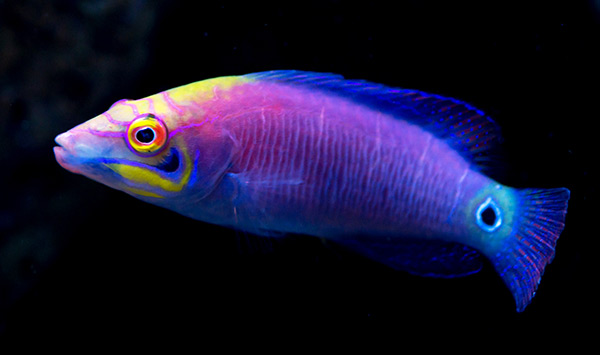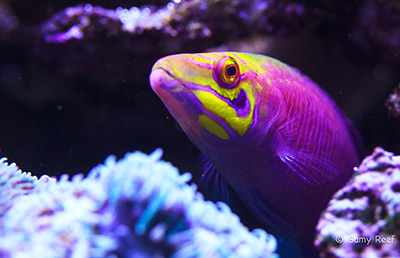Pseudocheilinus ocellatus, the mystery wrasse (aka the tail-spot wrasse, white-barred wrasse, or five-barred wrasse), is somewhat uncommon in the hobby and usually priced accordingly. But if you can get past the sticker shock for such a modest-sized fish, you’ll find this species can be a worthy aquarium candidate.
Physical traits
Exhibiting the banana-with-fins morphology typical of so many wrasses, this denizen of the western central Pacific reaches around 4 inches in length. Its yellow-rimmed eyes move independently and seem to be constantly appraising the goings on both inside and outside the tank. Base coloration is quite variable, commonly lavender to pinkish/purplish, while the face is yellow with purple/pink lines. The caudal peduncle is yellow and adorned with a prominent ocellus, or eyespot. A series of thin, white vertical bands may appear along the flanks, though these tend to fade as specimens mature.

Feeding
In nature, P. ocellatus feeds on small benthic invertebrates. Mysids, finely chopped seafoods, frozen formulations for small carnivores, and small, sinking pellets are some good options for captive specimens. Of course, live items in the tank will be sought and consumed as well. This can extend to small ornamental crustaceans and certain invertebrate cleanup crew members, so keep that in mind when choosing tankmates. On a positive note, this species, in common with many of its genus, is also known to feast on the pyramidellid snails and commensal flatworms that vex clams and corals.
Housing
Though P. ocellatus is a relatively small species, it’s an energetic swimmer that appreciates plenty of rockwork to refuge in. So, I wouldn’t advise keeping one in a tank much smaller than 50 gallons, though I have seen lower minimum housing recommendations. Also, this isn’t a burying wrasse, so a deep sand bed isn’t essential. Do, however, be sure to cover the top of the tank completely, as it can be a jumper!

Compatibility
P. ocellatus is a moderately aggressive species and may get snippy toward other fish that are similar in appearance/behavior (including conspecifics and other Pseudocheilinus spp.) or generally more shy and passive. It’s best to choose relatively assertive, dissimilar tankmates that aren’t so large that they can swallow a mystery wrasse.
Corals and other sessile invertebrates won’t be harmed in any way by this wrasse, making it a good candidate for reef systems. Just keep in mind that previous point about small motile invertebrates potentially being on the menu.



